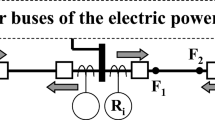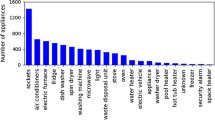Abstract
We consider the problem of fair allocation of the cost of a transmission system among load and generation entities using the marginal participation approach. We show that a cost-causal approach involving capacity-based line cost rate and a min-max fair economic slack bus selection for price-taking entities leads to a rigorously fair and more accurate implementation of marginal participation method. In the existing methods the counter-flows are masked, which is a compromise with fairness and linearity. However, if the counter-flows are incentivized then it can lead to pay-offs to some entities. The proposed approach solves the problem of pay-offs without masking the counter-flows. This is achieved by separation of the total transmission services cost into usage, reliability and residual capacity components. The allocation of the first two components is based on the min-max fairness policy, and the residual capacity costs are allocated on a pro-rata basis. Simulation results on multiple IEEE test systems, Indian utility power systems and extensive comparative evaluations for the contemporary methods demonstrate the claims made.













Similar content being viewed by others
Notes
the ability to schedule the least cost resource.
Abbreviations
- \({\mathcal {C}}\) :
-
The set of all the N-1 contingencies
- \({\mathcal {K}}\) :
-
Constant postage stamp rate to allocate RC
- \(C_{lm}\) :
-
Cost of line between bus l and m
- G :
-
Set of all generator buses
- L :
-
Set of all load buses
- NetCombCost :
-
Network combined cost for ‘extent of use’ and reliability capacity using DC framework
- NetEOUCost :
-
Network ‘extent of use’ cost using DC framework
- NetRelCapCost :
-
Network cost reliability capacity using DC framework
- \(P_{lm}\) :
-
Power flow in line lm using DC framework
- \(P_{{REL}_{lm}}\) :
-
Reliability capacity for line lm using DC framework
- \(PoC_1\) :
-
PoC tariff for DCPF-based proposed method
- \(RC_{REL}\) :
-
Residual capacity cost with reliability modelling in DC framework
- \(S_{lm}\) :
-
Capacity of the line lm in MW
- \(TSU^{0}\) :
-
Total network cost to be recovered
- UB :
-
Upper bound
- DCPF:
-
DC power flow
- PoC:
-
Point of connection tariff in ₹/MW
- RC:
-
Residual cost of the system
References
Pfeffer J L 1985 Policies governing transmission access and pricing: the wheeling debate revisited. Public Util. Fortn. (United States) 116: 9
Ilic Marija D, Yoon Y T, Zobian A and Paravalos M E 1997 Toward regional transmission provision and its pricing in new england. Util. Policy 6(3): 245–256
Green R 1997 Electricity transmission pricing: an international comparison. Util. Policy 6(3): 177–184
Perez-Arriaga Ignacio J and Smeers Yves 2003 Guidelines on Tariff Setting. In: Transport Pricing of Electricity Networks, Leveque Francois, editor chapter 7, pp. 175–203. Kluwer Academic Publishers
Perez-Arriaga Ignacio J, Rubio F J, Puerta J F, Arceluz J and Marin J 1995 Marginal pricing of transmission services: an analysis of cost recovery. IEEE Trans. Power Syst. 10(1): 546–553
Rudnick H, Palma R and Fernandez J E 1995 Marginal pricing and supplement cost allocation in transmission open access. IEEE Trans. Power Syst. 10(2): 1125–1132
Rubio-Oderiz F J and Perez-Arriaga I J 2000 Marginal pricing of transmission services: a cooperative analysis of network cost allocation methods. IEEE Trans. Power Syst. 15(1): 448–454
Vazquez C, Olmos L and Perez-Arriaga I J 2002 On the selection of the slack bus in mechanisms for transmission network cost allocation that are based on network utilization. In 15th Power System Computing Conference, PSCC, Seville
Galiana F D, Conejo A J, Gil H A 2003 Transmission network cost allocation based on equivalent bilateral exchanges. IEEE Trans. Power Syst. 18(4): 1425–1431
da Silva A M L, de Carvalho Costa J G and Lopes Lima L H 2013 A new methodology for cost allocation of transmission systems in interconnected energy markets. IEEE Trans. Power Syst. 28(2): 740–748
Orfanos G A, Georgilakis P S, Hatziargyriou N D 2013 A more fair power flow based transmission cost allocation scheme considering maximum line loading for n-1 security. IEEE Trans. Power Syst. 28(3): 3344–3352
Rao M S S and Soman S A 2015 Marginal pricing of transmission services using min-max fairness policy. IEEE Trans. Power Syst. 30(2): 573–584
Perez-Arriaga I J 2013 Regulation of the Power Sector. Power Systems. London: Springer
CERC. India jun 2010 Central electricity regulatory commission (sharing of inter state transmission charges and losses) regulations, 2010. Technical report, Central Electricity Regulatory Commission
Bialek J W and Kattuman P A 2004 Proportional sharing assumption in tracing methodology. IEE Proc. Gener. Transm. Distrib. 151(4): 526–532
Allan Kirschen R and Strbac G 2007 Implicit Slack Bus in the Calculation of Transmission Tariffs for the LRMC Methodology, PSR Tech. Rep.
Abhyankar A R, Soman S A and Khaparde S A 2007 Min-max fairness criteria for transmission fixed cost allocation. IEEE Trans. Power Syst. 22(4): 2094–2104
Rao M S S, Soman S A, Chitkara P, Gajbhiye R K, Hemachandra N and Menezes B L 2010 Min-max fair power flow tracing for transmission system usage cost allocation: a large system perspective. IEEE Trans. Power Syst. 25(3): 1457–1468
Yang Z, Zhong H, Xia Q, Kang C, Chen T and Li Y 2016 A structural transmission cost allocation scheme based on capacity usage identification. IEEE Trans. Power Syst. 31(4): 2876–2884
Jing Zhaoxia, Duan Xianzhong, Wen Fushuan, Ni Yixin and Wu F F 2003 Review of transmission fixed costs allocation methods. InPower Engineering Society General Meeting, 2003, IEEE, vol. 4, p. 2592
Nojeng S, Hassan M Y, Said D M, Abdullah M P and Hussin F 2014 Improving the mw-mile method using the power factor-based approach for pricing the transmission services. IEEE Trans. Power Syst. 29(5): 2042–2048
Telles E, Lima D A, Street A and Contreras J 2013 Min-max long run marginal cost to allocate transmission tariffs for transmission users. Electr. Power Syst. Res. 101(0): 25–35
Junqueira M, da Costa L C, Barroso L A, Oliveira G C, Thome L M and Pereira M V 2007 An Aumann–Shapley approach to allocate transmission service cost among network users in electricity markets. IEEE Trans. Power Syst. 22(4): 1532–1546
Mehta R and Soman S A Sept 2016 Efficient cost allocation for transmission system. In: 2016 IEEE International Conference on Power System Technology (POWERCON), pp. 1–6
Olmos L and Pérez-Arriaga I J 2009 A comprehensive approach for computation and implementation of efficient electricity transmission network charges. Energy Policy 37(12): 5285–5295
Orfanos G A, Tziasiou G T, Georgilakis P S and Hatziargyriou N D June 2011 Evaluation of transmission pricing methodologies for pool based electricity markets. In: PowerTech, 2011 IEEE Trondheim, pp. 1–8
Molina Y P, Saavedra O R and Amaris H 2013 Transmission network cost allocation based on circuit theory and the Aumann–Shapley method. IEEE Trans. Power Syst. 28(4): 4568–4577
National Electricity Policy, India 2005
Central Electricity Regulatory Commission (Sharing of Inter State Transmission Charges and Losses) (Third Amendment) Regulations, 2015
Zolezzi J M and Rudnick H 2002 Transmission cost allocation by cooperative games and coalition formation. IEEE Trans. Power Syst. 17(4): 1008–1015
Bakirtzis A, Biskas P, Maissis A, Coronides A, Kabouris J and Efstathiou M 2001 Comparison of two methods for long-run marginal cost-based transmission use-of-system pricing. IEE Proc. Gener. Transm. Distrib. 148(5): 477–481
Kirschen D and Strbac G 2004 Why investments do not prevent blackouts. Electr. J. 17(2): 29–36
Shirmohammadi D, Gribik P R, Law E T K, Malinowski J H and O’Donnell R E 1989 Evaluation of transmission network capacity use for wheeling transactions. IEEE Trans. Power Syst. 4(4): 1405–1413
MATLAB. version 8.4.0.150421 (R2014b). Natick: The MathWorks Inc., 2014
Inc. Gurobi Optimization. Gurobi Optimizer Reference Manual, 2015
Author information
Authors and Affiliations
Corresponding author
Rights and permissions
About this article
Cite this article
Mehta, R.P., Rao, M.S.S. & Soman, S.A. A cost-causal marginal participation method using min-max fairness for transmission services cost allocation. Sādhanā 45, 183 (2020). https://doi.org/10.1007/s12046-020-01418-x
Received:
Revised:
Accepted:
Published:
DOI: https://doi.org/10.1007/s12046-020-01418-x




